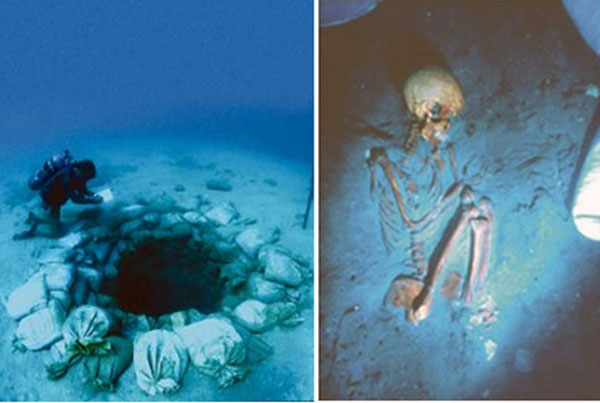Archaeologists Discovered A 9,000-year-old Underground Megalithic Settlement of Atlit Yam
In a groundbreaking discovery, archaeologists have uncovered a skeleton in the ancient underground city of Atlit Yam, which is believed to be around 9,000 years old.
The well-preserved city, located near the coast of Israel, has been the subject of extensive research for decades, but this recent find has the potential to reveal even more about the people who once inhabited the area.
The skeleton was found in a well-preserved state, with its bones and teeth intact. Experts are currently analyzing the remains in order to determine the gender, age, and cause of death.
The discovery of the skeleton is particularly significant because it provides a rare glimpse into the lives of the people who lived in the city during the Neolithic period.
Atlit Yam is a unique archaeological site that has been the subject of much interest over the years. The city was built on a small hill and was protected by a massive seawall, which is still visible 2023.
The city is believed to have been inhabited from around 8000 BCE until 5500 BCE and was likely a major center of trade and commerce in the region.

The discovery of the skeleton is just the latest in a series of exciting discoveries at Atlit Yam. In recent years, researchers have uncovered a number of artifacts and structures that provide insight into the daily lives of the people who once lived there. These discoveries include pottery, tools, and even a ritual bath.
The discovery of the skeleton is a major breakthrough in the study of Atlit Yam and has the potential to shed new light on the ancient city and its inhabitants.
As researchers continue to analyze the remains and other artifacts found at the site, we can expect to learn more about the fascinating history of this remarkable place.
Human Remains to Reveal the Oldest Known Case of Tuberculosis
Ten flexed burials encased in clay and covered by thick layers of sand were discovered, both inside the houses and in the vicinity of Atlit Yam, and in total archaeologists have uncovered 65 sets of human remains. One of the most significant discoveries of this ancient site is the presence of tuberculosis (TB) within the village.
The skeletons of a woman and child, found in 2008, have revealed the earliest known cases of tuberculosis in the world. The size of the infant’s bones, and the extent of TB damage, suggest the mother passed the disease to her baby shortly after birth.

What Caused Atlit Yam to Sink?
One of the greatest archaeological mysteries of Atlit Yam is how it came to be submerged, a question that has led to heated debate in academic circles.
An Italian study led by Maria Pareschi of the Italian National Institute of Geophysics and Volcanology in Pisa indicates that a volcanic collapse of the Eastern flank of Mount Etna 8,500 years ago would likely have caused a 40-meter-high tsunami to engulf some Mediterranean coastal cities within hours.
Some scientists point to the apparent abandonment of Atlit Yam around the same time, and the thousands of fish remains, as further evidence that such a tsunami did indeed occur.

However, other researchers have suggested that there is no solid evidence to suggest a tsunami wiped out the settlement. After all, the megalithic stone circle still remained standing in the place in which it had been constructed.
One alternative is that climate change caused glaciers to melt and sea levels to rise and the settlement became flooded by a slow rise in the level of the Mediterranean that led to a gradual abandonment of the village.
Whatever the cause of the submerging of the settlement, it was the unique conditions of clay and sandy sediment under salty water that enabled this ancient village to remain so well preserved over thousands of years.
